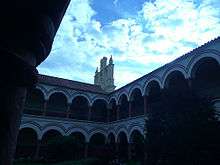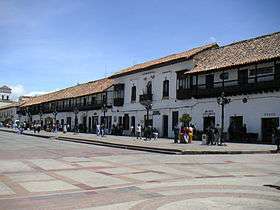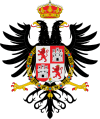Tunja
| Tunja | |||
|---|---|---|---|
| Municipality of Colombia | |||
|
Top left:Night view of Tunja Bolivar Square, Top right:House of Tunja Gonzalo Suarez Rendon, Middle left:Statue of Don Johan do Castellanos in Mayor Square, Middle upper left:Night view of Tunja Metropolitan Cathedral, middle lower right:The Boyaca Bridge in Boyaca Field, Bottom:Panorama view of Tunja, from north of hill | |||
| |||
 Location of Tunja in the department of Boyacá | |||
 Tunja Location in Colombia | |||
| Coordinates: 5°32′N 73°22′W / 5.533°N 73.367°WCoordinates: 5°32′N 73°22′W / 5.533°N 73.367°W | |||
| Country | Colombia | ||
| Department | Boyacá | ||
| Province | Central Boyacá Province | ||
| Founded | August 6, 1539 | ||
| Established | March 29, 1541 | ||
| Government | |||
| • Type | Municipality | ||
| • Mayor | Fernando Flórez | ||
| Area | |||
| • Municipality of Colombia | 121.4 km2 (46.9 sq mi) | ||
| • Urban | 13 km2 (5 sq mi) | ||
| Elevation | 2,820 m (9,250 ft) | ||
| Population (2011) | |||
| • Municipality of Colombia | 171,082 | ||
| • Density | 1,400/km2 (3,600/sq mi) | ||
| 181.407 habitantes.[1] | |||
| Demonym(s) | Tunjano | ||
| Postal code | 150001-150009 | ||
| Area code(s) | 57 + 8 | ||
| Website | Official website (Spanish) | ||
| IGAC - DANE - DIAN. | |||
Tunja (Spanish pronunciation: [ˈtuŋxa]) is a city located on the eastern range of the Colombian Andes, in the region known as the Altiplano Cundiboyacense, 130 km northeast of Bogotá. In 2012, it had an estimated population of 181,407 inhabitants.[1] It is the capital of Boyacá department and the Central Boyacá Province. Tunja is an important educational centre of known universities. It was founded by the Spanish in 1539.
Tunja is a tourist destination. In addition to its religious and historical sites it is host to several internationally known festivals and is a jumping-off point for regional tourist destinations such as Villa de Leyva, Paipa, and Sierra Nevada del Cocuy. It is also a stop on the Pan American Highway which connects Tunja to Bogota and Santa Marta and eventually to the Northern and Southernmost parts of the Americas.
History
Pre-Columbian Era
The earliest evidence of human population on the Altiplano Cundiboyacense has been dated to approximately 12.000 years ago. Homus Tequendama inhabited the area by 6,375 b.c, human skeletons, including arm bones have been found. Many archaeological discoveries were found in the city area, which seem to belong to 150 b.c.
During the First Millennium a.d., the territory was discovered by the Muiscas, descendants from the Chibcha family, who have emigrated from Central America through Panama to the Andean Region.[2]
First Muisca Era
An era when frequent battles among Cacicazgos took place, peace was proposed for the region and an agreement was made among Caciques to choose a supreme chief to rule them all. Hunzahua, who came from Ramiriqui was elected, and his confederation was named Hunza. Hunzahua took the title of Zaque ("great lord", the same meaning from Zipa who ruled Bacatá), and reign over the lands from the Chicamocha to Fusagasuga and from the Llanos de San Juan to Panche People and Muzo People frontiers , including Vélez territory. This unity helped to unify muisca language and religion, until Zipa Saguamanchica broke this unity due to differences with the Cacique of Guatavita.[3]
Last Muisca era (1490–1539)


Saguamanchica, with fifty thousand soldiers, decided on a massive attack on Zaque Michua,[4] crossing Guatavita and Choconta. Michua dealt with him, supported by an army which doubled Saguanmachica, battling around three hours and killing both chiefs. A new Zaque, Quemuenchatocha, was elected, during the tense truce between Bacatá and Hunza.
In 1514, Quemuenchatocha found out about the expansionist intentions of the new Zipa Nemequeme, and asked caciques of Gámeza, Iraca, Tundama and Sáchica to help him to reinforce his army. A battle was fought in Ventaquemada, and when Nemequene was about to become the victor, he was fatally wounded and his troops retired. Iraca retired his support and Quemuenchatocha got a truce which terms were about to end when the Spaniards arrived. When Quemuenchatocha found about the Europeans were around his lands, he decided to stay in Hunza and to avoid any aggression against the invaders. He forbade under strict penalties to show the invaders the path to his headquarters and when he knew they were reaching him, he sent them gifts and peacemakers, looking to stop them while he was hiding his treasures.
Hispanic Era (1539-1811)

Gonzalo Jimenez de Quesada parted from Santa Marta in April 1536, on an expedition to the south. His main concern was to find and get El Dorado. After months of travelling, he finds many Muisca cacicazgos in the Altiplano Cundiboyacense. In his search, he gets information about emerald discoveries and other treasures in Somondoco and the Llanos. Finally, on August 20, 1537, the conquerors arrived, with horses and dogs; Jimenez de Quesada arrived at Quemuenchatocha headquarters, finding him in a chair, dressed in gold in the same way of his companions, who ran off, leaving him alone. The gold, the emeralds and the fancy fabrics were taken. This conquest act took place where later San Agustin Cloister was built. Quemuenchatocha was taken to Suesca, with the hope he would reveal where he hid the rest of his treasure. He abdicate in favour of his niece Aquiminzaque and retired to Ramiriqui, where he died.[5]

Demographics and Geography
Tunja has a population of approximately 180,000 inhabitants and is located in north central Colombia. It has an elevation of 2.820 metres above sea level.
Climate
Tunja's climate is influenced by its location and altitude. At almost 3000m in elevation it is one of the highest cities in not only Colombia, but on Earth. As a result the city features a subtropical highland climate (Köppen Cfb) with little variation in temperature throughout the year but a distinct dry season from December to February.
| Climate data for Tunja, Colombia | |||||||||||||
|---|---|---|---|---|---|---|---|---|---|---|---|---|---|
| Month | Jan | Feb | Mar | Apr | May | Jun | Jul | Aug | Sep | Oct | Nov | Dec | Year |
| Average high °C (°F) | 19.1 (66.4) |
19.3 (66.7) |
19.2 (66.6) |
18.4 (65.1) |
17.3 (63.1) |
16.4 (61.5) |
16 (61) |
16.5 (61.7) |
17.3 (63.1) |
17.9 (64.2) |
18.2 (64.8) |
18.4 (65.1) |
17.83 (64.11) |
| Daily mean °C (°F) | 13.15 (55.67) |
13.7 (56.7) |
14.1 (57.4) |
14.05 (57.29) |
13.5 (56.3) |
12.75 (54.95) |
12.2 (54) |
12.35 (54.23) |
12.75 (54.95) |
13.3 (55.9) |
13.6 (56.5) |
13.1 (55.6) |
13.212 (55.791) |
| Average low °C (°F) | 7.2 (45) |
8.1 (46.6) |
9 (48) |
9.7 (49.5) |
9.7 (49.5) |
9.1 (48.4) |
8.2 (46.8) |
8.2 (46.8) |
6.7 (44.1) |
8.7 (47.7) |
9 (48) |
7.8 (46) |
8.45 (47.2) |
| Average precipitation mm (inches) | 16 (0.63) |
29 (1.14) |
55 (2.17) |
77 (3.03) |
84 (3.31) |
58 (2.28) |
46 (1.81) |
42 (1.65) |
54 (2.13) |
85 (3.35) |
69 (2.72) |
31 (1.22) |
646 (25.44) |
| Average precipitation days (≥ 1.0 mm) | 6 | 8 | 13 | 17 | 19 | 18 | 19 | 19 | 16 | 18 | 16 | 10 | 179 |
| Source: World Climates[6] | |||||||||||||
Security and living conditions
Tunja has the lowest homicide rate in Colombia and is below average in Latin America according to the latest report from the International Centre of the Prevention of Crime for 2010,[7][8] which is 7 with respect to the most dangerous city that is 128 crimes per hundred thousand inhabitants. According to other sources, this value is four times lower than the national average.[9] Tunja is an example of a safe city.[10]
Tourism

Relevant historical and touristic sites
The street are called in accord to 472[11] and google[12] nomenclatures; (C:Calle), (K:Carrera), (S:South), (E: East), (A: Ave).
Southern Sector
| English Name | Spanish Name | Address |
|---|---|---|
| Bridge of Boyaca | Puente de Boyacá | Rural Area (La Lajita) |
| Flower Pot Monument | Los Tiestos | K14-C16 |
| Mushroom Monument | Los Hongos | A Oriental |
| St. Martin's Church | Iglesia de San Martín | Libertador Neighborhood |
| Bullring | Plaza de Toros | K8-C13S |
Eastern Sector
| English Name | Spanish Name | Address |
|---|---|---|
| Botanical Garden | Jardín Botánico | BTS Highway (Autopista Circunvalar BTS) |
| St. Anthony's Church | Iglesia de San Antonio | San Antonio Neighborhood |
| Governorate Viaduct | Viaducto Paseo de La Gobernación | BTS-A.Olímpica |
| JNN Viaduct | Viaducto Jose Nepomuceno Niño | C24-Universitaria |
Downtown
| English name | Spanish name | Address |
|---|---|---|
| Las Nieves Church and Square | Iglesia y Plazoleta de las Nieves | K10-C22 |
| St. Ignatius' Church | Iglesia de San Ignacio | K10-C18 |
| *St. Barbara's Church | Iglesia de Santa Bárbara | K11-C17 |
| St. Dominic's Church | Iglesia de Santo Domingo | K11-C19 |
| St. Laureano's Church | Iglesia de San Laureano | K9-C15 |
| St. Lazarus Hill and Church | Loma e Iglesia de San Lázaro | San Lázaro Neighborhood |
| St. Claire Royal Convent | Convento de Santa Clara la Real | K11-C21 |
| St. Francis Church | Iglesia de San Francisco | K10-21A |
| Cathedral Basilica of St. James the Apostle in Tunja[13] | Catedral Basílica Metropolitana Santiago de Tunja | Bolivar Square |
| Meetinghouse of The Church of Jesus Christ of Latter-day Saints | La Iglesia de Jesucristo de los Santos de los Últimos Días | C12-K10 |
| Our Lady of Miracles Church | Iglesia de Nuestra Señora del Milagro (El Topo) | K15-C19 |
| St. Augustine Cloister | Claustro de San Agustín | K9-C23 |
| Cojines del Zaque | Cojines del Zaque | K4-C12 |
| Republic Forest | Bosque de la República | K11-C14 |
| Freedom Obelisk | Obelisco de la Libertad | K10-C14 |
| City Founder Palace and Museum | Casa Museo del Fundador | Bolívar Square |
| Juan de Castellanos' Palace and Museum | Casa Museo Juan de Castellanos | Bolívar Square |
| Don Juan de Vargas' Palace and Museum | Casa Museo Don Juan de Vargas | K9-C20 |
| Bolivar Square | Plaza de Bolívar | K9-C19 |
| Tower Palace (Governorate Palace of Boyacá) | Palacio de la Torre | Bolívar Square K10-C20 |
| Rojas Pinilla's House | Casa Cultural Rojas Pinilla | K11-C16 |
| Martyr's Wall Monument | Paredón de los Mártires | K9-C14 |
| La Pila del Mono's Fountain | La Pila del Mono | K9-C20 |
| Royal Palace (currently a shopping mall) | Plaza Real | K14-C20 |
| St. Thomas University Building | Edificio Universidad Santo Tomás | K12-C19 |
| Santander Park | Parque Santander | A Colón |
| Pinzón Park | Parque Pinzón | K8-C23 |
| Maldonado Park | Parque Maldonado | C10-C30 |
| La Esperanza Park | Parque La Esperanza | |
| Hoyo del Trigo Park | Parque Hoyo del Trigo | C22-K12 |
Northern Sector
| English name | Spanish name | Address |
|---|---|---|
| St. Agnes' Church | Iglesia de Santa Inés | C42-A Norte |
| Hunzahua's Stream Pool | Pozo de Hunzahúa | A Norte, UPTC |
| Indigenous Race Monument | Monumento a la raza indígena | La Glorieta |
| Campus of the Uptc and its natural reserve | Campus de la Uptc y su reserva natural | A Norte, UPTC |
| Museum of Natural History | Museo de Historia Natural | A Norte, UPTC |
| Museum of Anthropology | Museo de Antropología | A Norte, UPTC |
| The Independence Stadium | Estadio de La Independencia | A Olímpica |
| Olympic Village | Villa Olímpica | A Olímpica |
Festivals

Shopping
Downtown
People have been shopping in downtown Tunja for over 450 years. The most important interesting places are:
- El Cid
- El Virrey
- Teatro Boyacá
- Cinema Boyacá

Shopping Malls
Unicentro is an American style shopping center that features a Jumbo and a Cinemark Theatres.
Traditional Markets
Plaza de Mercado del Norte Plaza de Mercado del Sur
Notable people
- Nairo Quintana
- Winner Anacona
- Gustavo Rojas Pinilla
- Juan Carlos Pinzón
- Rafael Humberto Moreno Durán
- Guillermo Prieto La Rotta
Education
Tunja is also notable for its great contribution to education in Colombia, despite being considered a small town, a large part of its population are students between high school and university. Tunja has a large number of colleges, among these is the College of Boyaca, first public school in the territories of Venezuela, Ecuador, Panama and Colombia when these countries were part of Gran Colombia. It was founded on 20 October 1822 by the Vice President Francisco de Paula Santander. Among the most relevant schools are:

- Colegio de Boyacá
- Institucion Educativa San Jeronimo Emiliani
- Colegio Salesiano Maldonado
- Colegio INEM Carlos Arturo Torres
- Colegio de la Presentación
- Gimnasio Campestre del Norte.
- Colegio Municipal Silvino Rodríguez
- Normal Superior Santiago de Tunja.
- Escuela Normal Femenina "Leonor Álvarez Pinzón"
- Colegio Los Angeles
- Colegio Militar Juan José Rondón
- Colegio de Nuestra Señora del Rosario
- Colegio Gustavo Rojas Pinilla.
- Colegio Andino
- Colegio American School Saint Frances.
- Country Bilingual School
Universities
Tunja's major university, The Pedagogical and Technological University of Colombia, was founded by General Gustavo Rojas Pinilla, and is one of the public universities in Colombia. Other universities are:
- Pedagogical and Technological University of Colombia
- University of Boyaca
- Universidad Santo Tomás
- Escuela Superior de Administración Pública E.S.A.P.
- Universidad Nacional Abierta y a Distancia (UNAD)
- Fundacion Universitaria Juan de Castellanos
- Corporación Universitaria Remington(CUR-Cread Boyacá)
- Universidad Antonio Nariño
- Universidad Pontificia Bolivariana de Colombia
- Instituto Universitario de la Música y las Artes
Sports
The city has two professional football teams. Boyaca Chico and Patriotas F.C. play in the Colombian Professional Football A league. Both play their games at La Independencia Stadium located in the north of the city. The stadium was rebuilt for the Copa Libertadores 2009, expanding capacity to 20,630 spectators and meeting FIFA specifications. The city organized the 2008 South American U-20 Futsal Cup, in which Brazil was awarded as the championship. Colombia secured the fourth position in the tournament. Now, the stadium is in the process of being remodeled. The city has a professional basketball team called Patriotas that plays in the Saludcoop Invitational Cup. This team plays its matches in the Municipality Colosseum that has a capacity to 5,000 spectators.
Sister cities
-
 Colombia: Pamplona[17] (2012)
Colombia: Pamplona[17] (2012) -
 Spain: Toledo[17] (2013)
Spain: Toledo[17] (2013) -
 Colombia: Popayán[17] (2012)
Colombia: Popayán[17] (2012) -
 Spain: Málaga[17] (2013)
Spain: Málaga[17] (2013) -
 Italy: Potenza[18] (2009)
Italy: Potenza[18] (2009)
References
- 1 2 "estimated 2011" (PDF). D.A.N.E. Retrieved 2011-11-30.
- ↑ "Los orígenes remotos de Tunja". Retrieved 31 August 2011.
- ↑ http://pueblosoriginarios.com/biografias/hunzahua.html
- ↑ http://pueblosoriginarios.com/biografias/michua.html
- ↑ http://pueblosoriginarios.com/biografias/quemen.html
- ↑ "Climate Data and Activities". World Climates. Retrieved 1 May 2015.
- ↑ Page officiel de la municipalité en espagnol
- ↑ International Centre of the Prevention of Crime, International report Crime prevention and Community safety: Trends and perspectives 2010
- ↑ Eduardo Posada Carb, journal El Tiempo, Colombia 2011
- ↑ Review The Safe cities in Colombia. December 2011 in Spanish
- ↑ 472 La Red Postal
- ↑ Tunja Google Maps
- ↑ Nombre oficial de la Catedral de Tunja
- ↑ "www.festivalinternacionaldelacultura.com". www.festivalinternacionaldelacultura.com. Retrieved 2010-04-17.
- ↑ "Semana Santa". www.tunja.gov. Retrieved 2010-04-17.
- ↑ "Aguinaldo Boyacense La Fiesta Grande de Boyacá para Colombia". www.tunja.gov. Retrieved 2010-04-17.
- 1 2 3 4 http://www.tunja.gov.co/?idcategoria=15278 Hermanamiento Semana Santa
- ↑ Hermanamiento con la Región de Basilicata (Italia)
External links
- Tunja entry in Wikipedia Español
- Tunja Distrito Cultural y Turístico www.expotunja.com
- of Tunja Municipal Government
- News from Tunja at El Diario de Tunja
- News from Tunja at Excelsio
- News from Tunja at Mi Tunja.net
|


